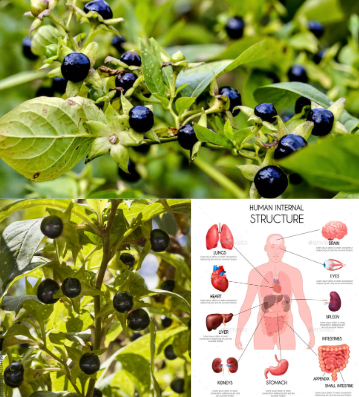
Mysterious, beautiful, and lethally dangerous — Deadly Nightshade, or Atropa belladonna, is one of the most infamous plants in history. With its deep purple flowers and glossy black berries, it has seduced herbalists, enchanted mystics, and terrified physicians for centuries. But behind its alluring appearance lies a cocktail of potent toxins capable of causing hallucinations, paralysis, and even death.
So why has humanity been drawn to such a perilous plant? And is there any safe way to use it? Let’s dive into its fascinating history, deadly effects, and surprising role in modern medicine.
What Exactly Is Deadly Nightshade?
Atropa belladonna is a perennial herb belonging to the Solanaceae family — the same botanical group as tomatoes and potatoes, though infinitely more dangerous. Native to Europe, North Africa, and Western Asia, it can grow up to six feet tall, with lush green leaves, bell-shaped purple flowers, and clusters of glossy black berries.
Every part of the plant — from roots to fruit — contains toxic alkaloids that disrupt the nervous system. These include:
- Atropine – Can cause rapid heartbeat, hallucinations, and paralysis.
- Scopolamine – Known for its powerful mind-altering effects.
- Hyoscyamine – Interferes with nerve signals, sometimes fatally.
These compounds block neurotransmitters, leading to symptoms ranging from dry mouth and blurred vision to respiratory failure in severe poisoning cases.
A Plant Steeped in History and Folklore
Deadly Nightshade’s story weaves through ancient warfare, medieval witchcraft, Renaissance beauty trends, and medical innovation.
Ancient Rome and Greece
Poisoners and assassins valued belladonna for its silent, lethal efficiency. Romans even coated arrow tips with its extracts.
Medieval Witchcraft and Sorcery
Legends link belladonna to “flying ointments” used by witches to induce visions. It was believed to open the mind to altered states — at a dangerous cost.
Renaissance Beauty Secrets
The name “belladonna” means “beautiful lady” in Italian, inspired by women who used its juice to dilate their pupils for a seductive look. Sadly, repeated use often led to blindness.
Video : Deadly Nightshade Has The Deadliest Berries On Earth
Modern Medicine
Despite its notoriety, belladonna is still valued for its alkaloids. Extracts have been used to make eye drops, muscle relaxants, motion sickness patches, and even antidotes for nerve gas poisoning.
Recognizing Symptoms of Belladonna Poisoning
Accidental ingestion, even in small amounts, can trigger severe symptoms within hours.
Mild signs:
- Dry mouth and throat
- Dilated pupils
- Blurred vision
- Rapid heartbeat
- Confusion and dizziness
Severe signs:
- Hallucinations and delirium
- Convulsions
- Muscle paralysis
- Difficulty breathing
- Coma or death
Children are at particularly high risk because the berries look tempting and sweet. Pets and livestock can also suffer fatal consequences.
Is It Ever Safe to Use?
In the wild — absolutely not. But in a controlled pharmaceutical setting, certain belladonna-derived compounds are highly valuable.
Medical applications include:
- Ophthalmology – Atropine eye drops for diagnostic pupil dilation
- Neurology – Muscle relaxants for certain disorders
- Travel health – Scopolamine patches for motion sickness prevention
- Emergency medicine – Atropine as an antidote for nerve agent exposure
The key difference is dosage control. Outside a lab or clinical environment, the risks far outweigh the rewards.
How to Identify and Avoid Deadly Nightshade
Misidentification can be deadly. Here’s what to look for:
- Flowers – Bell-shaped, purple with greenish tinges
- Leaves – Large, oval, dark green
- Berries – Glossy black, about the size of a cherry
- Height – Up to six feet tall
If you forage wild plants, follow safe practices:
- Never eat berries or leaves from unidentified plants.
- Learn the difference between edible nightshades (like blackberries) and belladonna.
- Keep children and pets away from areas where it grows.
Should You Grow Belladonna?
For most people, the answer is no. While some gardeners cultivate it for ornamental or research purposes, its extreme toxicity makes it risky to have around homes, especially with children or animals.
Belladonna’s place is best left in history books, botanical gardens, and controlled laboratories — not in your backyard.
Video : How This Poisonous Plant Became Medicine (Belladonna) | Patrick Kelly
Conclusion
Deadly Nightshade is a rare blend of beauty and danger. It has shaped history through assassination plots, mystical rituals, and even high-fashion beauty trends. Today, its derivatives save lives in medicine — but only when handled with absolute precision.
Admire its dark elegance from a safe distance, and remember: in nature, the most beautiful things can be the most dangerous.


